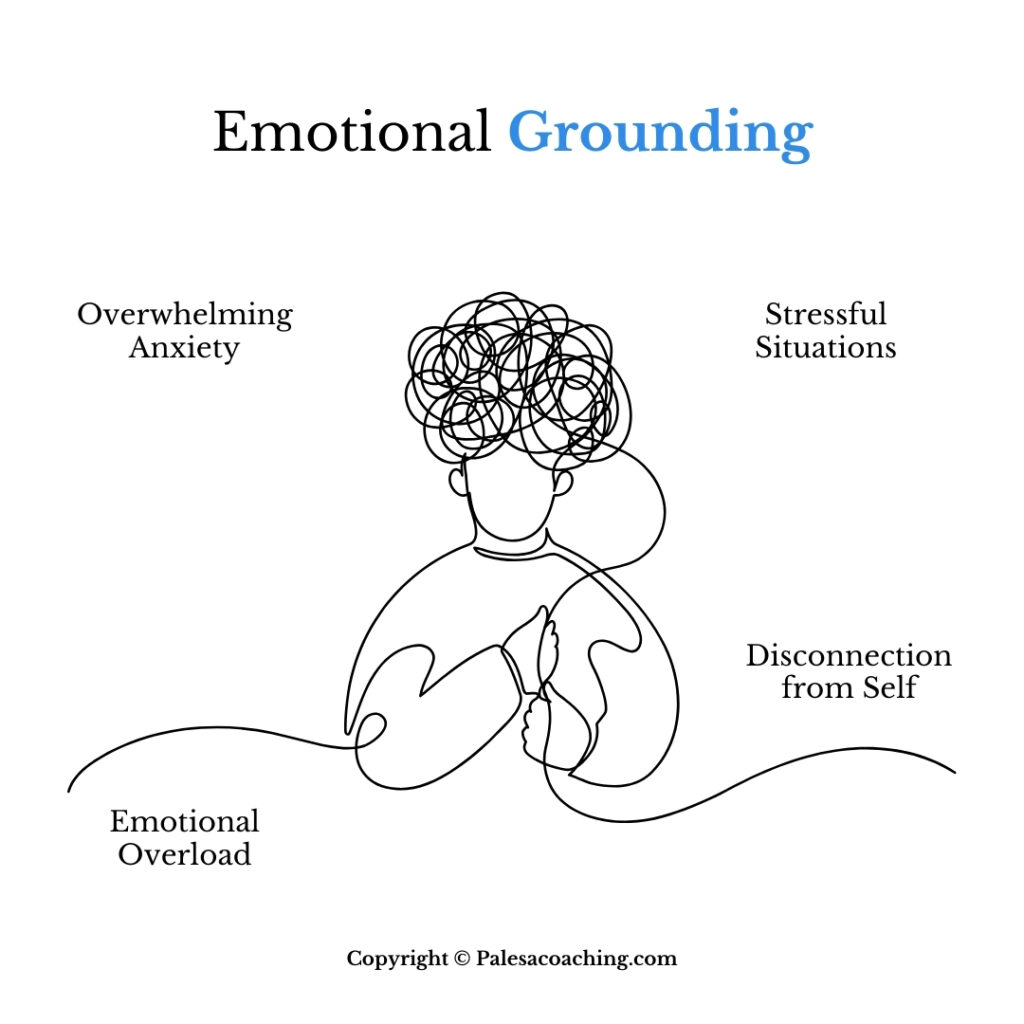Life is full of challenges, and sometimes it can feel like we’re barely holding on. Whether it’s dealing with personal stressors, managing relationships, or navigating the complexities of work and life, our emotions can easily become overwhelming. When we’re caught in the midst of emotional turbulence, it’s natural to feel unsteady or disconnected from ourselves. This is where anchoring techniques, grounded in Acceptance and Commitment Therapy (ACT), can make a profound difference.
I believe that everyone deserves to feel grounded and secure, no matter what life throws their way. Anchoring techniques provide practical tools to help you maintain emotional stability, bringing you back to a place of calm and clarity, even in the most challenging times. In this blog, we’ll explore the concept of emotional grounding, introduce practical anchoring techniques you can use during emotional turbulence, and discuss how incorporating these practices into your daily life can enhance your overall well-being.

Understanding the Need for Emotional Grounding
We all experience moments when life feels overwhelming—when our emotions are so intense that it’s hard to think clearly or make decisions. In these moments, it’s easy to get caught up in negative thought patterns or become disconnected from the present. Emotional grounding, or anchoring, is the process of reconnecting with the present moment in a way that stabilizes our emotions and brings us back to a place of balance (Hayes, Strosahl, & Wilson, 2016).
But why is emotional grounding so important? Let’s explore some of the common scenarios where anchoring can be particularly beneficial:
Overwhelming Anxiety:
Anxiety can make us feel like we’re spiraling out of control. It often brings with it a sense of impending doom, racing thoughts, and physical symptoms like a pounding heart or shortness of breath. In these moments, anchoring techniques can help us reconnect with the present and break the cycle of anxious thoughts (Bourne, 2015).
Stressful Situations:
Whether it’s a tight deadline at work, a difficult conversation, or juggling multiple responsibilities, stress can leave us feeling frazzled and on edge. Anchoring techniques provide a way to pause, take a breath, and approach the situation with a calmer, clearer mind (Linehan, 2015).
Emotional Overload:
Sometimes, our emotions can feel like too much to handle. This might happen during moments of grief, anger, or even excitement. When our emotions are intense, it’s easy to feel overwhelmed. Anchoring helps us create a safe emotional space where we can process these feelings without being consumed by them (Neff, 2011).
Disconnection from Self:
In the hustle and bustle of daily life, it’s easy to lose touch with ourselves. We might feel disconnected from our values, our goals, or even our sense of identity. Anchoring techniques allow us to reconnect with our inner self, providing a sense of stability and purpose (Germer, Siegel, & Fulton, 2016).

The Science Behind Anchoring in ACT
Acceptance and Commitment Therapy (ACT) is a modern form of cognitive-behavioral therapy that focuses on helping individuals live a meaningful life, even in the face of difficult emotions (Hayes, Strosahl, & Wilson, 2016). One of the core principles of ACT is psychological flexibility, which is the ability to stay connected to the present moment while pursuing valued life goals, even when uncomfortable emotions arise.
Anchoring techniques are closely aligned with the principles of ACT because they promote mindfulness—a key component of psychological flexibility (Kabat-Zinn, 1994). Mindfulness in ACT is about being open to and aware of the present moment without trying to avoid or escape uncomfortable emotions. Instead of getting lost in thoughts about the past or future, anchoring helps us stay grounded in the here and now.
When we use anchoring techniques, we’re essentially practicing mindfulness. We’re bringing our attention back to the present moment and observing our thoughts and feelings without judgment. This practice not only helps us manage emotional turbulence in the moment but also strengthens our psychological resilience over time (Segal, Williams, & Teasdale, 2018).
Practical Steps to Anchor Yourself During Emotional Turbulence
Anchoring techniques are not only effective but also simple to practice. Here are several techniques you can use to ground yourself when emotions start to feel overwhelming:
The 5-4-3-2-1 Technique:
Overview: This technique uses your five senses to anchor you in the present moment.
How to Practice: Start by identifying five things you can see around you. Then, touch four different objects, focusing on their texture. Next, listen for three distinct sounds, followed by identifying two things you can smell. Finally, notice one thing you can taste. This exercise helps shift your focus away from overwhelming thoughts and back to the present moment (Harris, 2019).
Why It Works: By engaging your senses, this technique interrupts the flow of anxious or overwhelming thoughts and grounds you in the here and now.
Breath Awareness:
Overview: Your breath is a powerful tool for calming the mind and body.
How to Practice: When you feel emotionally unsteady, take a moment to focus on your breath. Inhale deeply through your nose, hold for a few seconds, and then exhale slowly through your mouth. Repeat this process several times, paying close attention to the sensation of the breath entering and leaving your body.
Why It Works: Deep, mindful breathing activates the parasympathetic nervous system, which helps reduce the body’s stress response and brings a sense of calm (Kabat-Zinn, 1994).
Physical Grounding:
Overview: Physical grounding involves using your body to anchor yourself in the present moment.
How to Practice: Stand or sit with your feet firmly planted on the ground. Feel the connection between your feet and the floor. You can also press your hands against a solid surface, such as a table or wall, focusing on the sensation of touch. Another option is to hold an object, like a stone or piece of fabric, and concentrate on its texture and weight.
Why It Works: Physical sensations are immediate and real, making them effective anchors that can bring you back to the present when emotions feel overwhelming (Linehan, 2015).
Visualization:
Overview: Visualization is a mental technique that helps create a safe space in your mind.
How to Practice: Close your eyes and imagine yourself in a peaceful place—a beach, a forest, or any setting that makes you feel calm and secure. Engage all your senses in this visualization: see the colors, hear the sounds, and feel the sensations of this safe place. Spend a few minutes fully immersed in this mental escape.
Why It Works: Visualization allows you to retreat to a place of safety and calm mentally, providing emotional relief and grounding during stressful moments (Neff, 2011).
Progressive Muscle Relaxation:
Overview: Progressive muscle relaxation involves tensing and then slowly relaxing different muscle groups in the body.
How to Practice: Start with your toes and work your way up to your head, tensing each muscle group for a few seconds and then slowly releasing the tension. Pay attention to the difference between tension and relaxation in your body.
Why It Works: This technique not only helps relieve physical tension but also shifts your focus away from overwhelming emotions and back to the physical sensations in your body (Feliu-Soler et al., 2016).
Incorporating Anchoring into Daily Practice for Enhanced Well-being
While anchoring techniques are incredibly useful in moments of emotional turbulence, they can also be incorporated into your daily routine as a proactive measure to enhance your overall emotional well-being. Regular practice of these techniques can help you build a stronger foundation for managing stress, anxiety, and other emotional challenges.
- Morning Routine:
- Start Your Day with Grounding: Begin your day with a grounding exercise, such as breath awareness or a quick 5-4-3-2-1 scan. This simple practice can set a stable emotional tone for the day, helping you approach challenges with greater resilience (Harris, 2019).
- Incorporate Visualization:
Consider incorporating a brief visualization exercise into your morning routine. Visualize yourself moving through the day with calm and confidence, handling any challenges that arise with grace (Kabat-Zinn, 1994).
- Mindful Breaks:
- Pause and Ground: Throughout the day, take short breaks to practice grounding techniques. Whether you’re at work, running errands, or spending time with family, these mindful pauses can help you stay connected to the present and prevent stress from building up (Linehan, 2015).
- Use Breath Awareness: During these breaks, practice a few rounds of mindful breathing. This can be especially helpful during high-stress moments, like before a big meeting or after a challenging conversation (Kabat-Zinn, 1994).
- Evening Reflection:
- Wind Down with Grounding: As the day comes to an end, take a few moments to release any accumulated stress with a grounding practice. This might involve journaling about your experiences, practicing gratitude, or engaging in a relaxing visualization (Neff, 2011).
- Practice Progressive Muscle Relaxation: Progressive muscle relaxation can be particularly effective in the evening, helping you unwind physically and mentally before bed (Feliu-Soler et al., 2016).
- Cultivating Awareness:
- Build Emotional Awareness: The key to effective anchoring is awareness. Pay attention to the moments when you feel emotionally unsteady, and make a conscious effort to use an anchoring technique. The more you practice, the more natural it will become to ground yourself during stressful moments (Harris, 2019).
- Reflect on Your Practice: At the end of each day or week, take a moment to reflect on your use of anchoring techniques. What worked well for you? What could you improve? This reflection will help you deepen your practice over time (Segal, Williams, & Teasdale, 2018).
- Build Emotional Awareness: The key to effective anchoring is awareness. Pay attention to the moments when you feel emotionally unsteady, and make a conscious effort to use an anchoring technique. The more you practice, the more natural it will become to ground yourself during stressful moments (Harris, 2019).

Conclusion
Emotional stability doesn’t mean never experiencing difficult emotions—it means having the tools to navigate those emotions with grace, resilience, and self-compassion. Anchoring techniques, as part of Acceptance and Commitment Therapy, offer practical and effective ways to ground yourself during emotional turbulence and maintain your emotional well-being.
I’m here to support you in your journey toward greater emotional stability and resilience. I believe that with the right tools and guidance, everyone can cultivate a strong foundation of emotional well-being (Hayes, Strosahl, & Wilson, 2016). By incorporating anchoring techniques into your daily life, you can create a safe and stable emotional environment for yourself, no matter what challenges come your way.
Remember, it’s okay to take it one step at a time. Whether you’re just beginning to explore these techniques or looking to deepen your practice, I’m always here to walk alongside you, offering encouragement and support every step of the way (Neff, 2011). Reach out to me today, and let’s explore how anchoring techniques can bring more peace, stability, and well-being into your life.
References:
- Hayes, S. C., Strosahl, K. D., & Wilson, K. G. (2016). Acceptance and Commitment Therapy: The Process and Practice of Mindful Change (2nd ed.). The Guilford Press.
- Harris, R. (2019). ACT Made Simple: An Easy-to-Read Primer on Acceptance and Commitment Therapy (2nd ed.). New Harbinger Publications.
- Neff, K. D. (2011). Self-Compassion: The Proven Power of Being Kind to Yourself. HarperCollins.
- Kabat-Zinn, J. (1994). Wherever You Go, There You Are: Mindfulness Meditation in Everyday Life. Hyperion.
- Linehan, M. M. (2015). DBT Skills Training Manual (2nd ed.). The Guilford Press.
- Bourne, E. J. (2015). The Anxiety and Phobia Workbook (6th ed.). New Harbinger Publications.
- Segal, Z. V., Williams, J. M. G., & Teasdale, J. D. (2018). Mindfulness-Based Cognitive Therapy for Depression (2nd ed.). The Guilford Press.
- Germer, C. K., Siegel, R. D., & Fulton, P. R. (Eds.). (2016). Mindfulness and Psychotherapy (2nd ed.). The Guilford Press.
- Feliu-Soler, A., Pascual, J. C., Elices, M., Martín-Blanco, A., Carmona, C., Cebolla, A., Soriano, J., Ruiz, J., & Soler, J. (2016). “Fostering Self-Compassion and